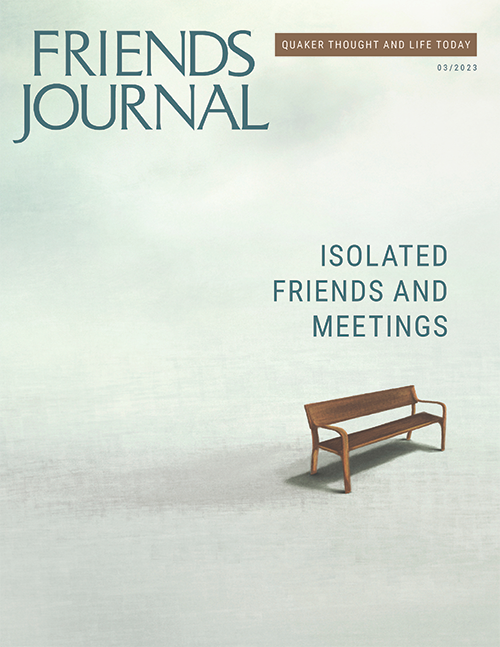I am a strong believer in the necessity of finding ways to connect with other people, to forge community, and develop our own identities—spiritual, or otherwise—whether or not that involves being in physical proximity to one another. Some of us are fortunate enough to be located in places where there are myriad opportunities for in-person connection to other Quakers, but far, far more of us find ourselves isolated. Since its founding in the 1820s, this magazine has served a purpose as a technological aid to those seeking connection to Quakers. One of the more common kinds of letters we receive in our office is a hearty thank you from someone who lives far away from any Quaker meeting, whose most important connection with other Friends is one nurtured by the voices they encounter in our pages. My response to them often goes something like this: I’m so grateful that this magazine-mediated connection we share gives me the opportunity to be in community with you, too.
As the authors in this issue explore from various angles, the nature of isolation within and among the Religious Society of Friends is changing rapidly before our eyes. Technology giveth, and technology taketh away. William Kiel describes a flowing into and out of Quaker real-life gatherings that has led to an increased feeling of belonging and identification with Friends. Ann Jerome shares her experiences with a new kind of informal, online Quaker group emerging from the shadow of COVID, a recipe that others might follow to develop on their own. Linda Seger, a Colorado-based Friend, places our new age of digital connectedness and experimentation in the grand tradition of Quakerism and delights in forming strong bonds with a meeting 2,000 miles away in Maine. Anita Bushell warns of the toll of relying too much on tools like Zoom, and Helen Berkeley writes of her own yearning for what might now seem increasingly old-fashioned: in-person and analog, face-to-face Quaker worship. Our own Sharlee DiMenichi canvasses Friends about how they are experimenting with and integrating virtual meetings into the fabric of their communities.
Oftentimes, as a Quaker meeting grows in membership and resources, it becomes possible and desirable to develop multiple opportunities for worship. Participants will gravitate toward the ones that best fulfill their needs. As these subgroups mature and develop their own cultures and articulation of values, this can lead to splits or spinoffs, even absent any underlying discontent or conflict. I foresee that Quakers’ ongoing experimentation with virtual and hybrid meeting formats as well as “analog” meetings will lead to the perception, if not the reality, of fragmentation (even as it represents that blooming of a thousand flowers for folks with differing capacities and needs for connection). It’s going to be challenging for the “mothership” communities that encourage and sponsor this kind of experimentation to remain whole and relevant. I don’t mean to say that new formats and gathering styles shouldn’t be explored, just that the coherence of the larger society will be tested and stretched in new ways. I hope that the end result is, at least, a net increase in the number of us who feel connected, as well as an increase in the overall accessibility of Quakerism to those who might join us.
How do you define connection and isolation? And where do you see the Religious Society of Friends heading? As always, I welcome your thoughts as a fellow traveler.





Comments on Friendsjournal.org may be used in the Forum of the print magazine and may be edited for length and clarity.